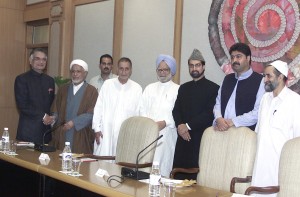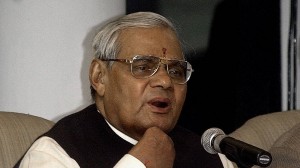Peace Watch » Kashmir-Talk » “Vajpayee Syndrome” and Kashmir Leaders?
“Vajpayee Syndrome” and Kashmir Leaders?
The ‘Vajpayee Syndrome’
Will India’s new PM follow Atalji’s model on Kashmir
Z. G. MUHAMMAD
The enthusiasm in the Ilahaqi political parties in the state for the sixteenth Lok Sabha elections is on the expected lines. For these parties it is an opportunity for testing their strength for the 2014 Assembly elections. Nevertheless, very high expectations in a section of the “pro-freedom” leadership that ‘Narendra Modi led NDA government if elected will move an extra mile for resolving the Kashmir dispute is unprecedented.
On 19 March, most of the newspaper carried on front-page statement by chairman of one of the three factions of the Hurriyat Conferences exuding with optimism that India’s new premier will follow the footsteps of Atal Bihari Vajpayee in addressing the Kashmir problem. Castigating, the UPA government for its “anti-Kashmir” policies he called upon the BJP leadership to adopt Vajpayee’s Kashmir policy if elected to power. On 20 March, the BJP spokesperson Nirmala Sitarahman reacting to the vibes and the sound bites emanating from the ‘resistance camps’ in Kashmir, generally recognized in official lexicon as the ‘moderates’ stated that Modi will “bring back the days of Vajpayee when there was more engagement with Jammu and Kashmir to ensure that peace and development reached the state.”
The debate became interesting after the former intelligence chief of India A.S. Daulat joined it and substantiated the statement of the APHC Chairman, stating if Narendra Modi comes to power, he will follow the policies of Vajpayee on Kashmir.’ For his proximity to the power centers in the capital and leadership in Kashmir his views are not easily dismissed in media but are mostly seen as leads for understanding the emerging political scenario in the state.
I see two reasons for this extraordinary warm up in this group of leaders: One, the “Vajpayee syndrome,” which for past over a decade has been afflicting this faction. Two, Narendra Modi’s speech at Jammu that apparently sounded a mellow down in the BJP traditional approach towards Kashmir.
 Nonetheless, the debate sparked by the APHC Chairman raises three important questions. One, what was the much talked about Kashmir policy of Atal Bihari Vajpayee and if there was one did it envisage a final settlement of Jammu and Kashmir. Two, did the UPA government really suffer from an inertia that prevented it from ‘engaging’ with some willing Hurriyat leaders. Third if Narendra Modi will dare to take a departure from the RSS stand on Kashmir and move forward for the resolution of the dispute.
Nonetheless, the debate sparked by the APHC Chairman raises three important questions. One, what was the much talked about Kashmir policy of Atal Bihari Vajpayee and if there was one did it envisage a final settlement of Jammu and Kashmir. Two, did the UPA government really suffer from an inertia that prevented it from ‘engaging’ with some willing Hurriyat leaders. Third if Narendra Modi will dare to take a departure from the RSS stand on Kashmir and move forward for the resolution of the dispute.
Some Kashmir leaders continue to be prisoners of one and half decade old statement of Atal Bihari Vajpayee at a Srinagar press conference stating that the Constitution should not become obstacle in a dialogue with militants it could be held within the ambit of “insaaniyat”. The statement was not indicative of any departure in New Delhi’s Kashmir policy but had a definite context. ‘This breaking from traditional mold was a response to the unilateral ceasefire announced by Hizbul Mujahedeen.’ Clarifying the use of word ‘insaaniyat’ in his press conference he told Parliament, “Whether talks are held within the Constitution or outside is not so important. What is important is that underground terrorist groups should be brought over ground. Because, if such groups continue to function and thrive underground, not only will problems of Jammu and Kashmir remain unsolved but the country’s as well.”
The word ‘insaaniyat’ that crept into New Delhi’s Kashmir discourse in no way was a paradigm shift in its Kashmir policy or a forward movement towards the resolution of the dispute but it was an intelligent phrase coined by Vajpayee to silence even the last militant gun. Engagement of Vajpayee with Hizbul Mujahedeen, with some “pro-freedom” Kashmir leaders, or despite setbacks doggedly pursuing peace agenda with Pakistan was not something that was happening in isolation. It was in fact a manifestation of drastic change in thinking in India about third party mediation in Kashmir and US President George Bush’ deep interest for peace between India and Pakistan and settling their disputes amicably. Discussing this change Navnita Chadda Behera in book Demystifying Kashmir writes, ‘India was ready to accept a discreet American Role- which Vajpayee referred to as facilitation in promoting settlement of the Kashmir Dispute. Formal mediation by the international community was still politically taboo.’(Demystifying Kashmir page 229).
In putting India and Pakistan in reconciliatory mode America was pursuing two goals one pursuing its nuclear agreements with India and second forging strategic relations with Pakistan to have a better say in South Asia. Looking dispassionately at role the played by UPA government after the end of the Vajpayee government, it would be wrong to say that it did not pursue the policy of fostering peace with Pakistan. One of major achievements of UPA was opening of Srinagar-Muzzafarabad road and other routes between two parts of Kashmir. Starting bus services between two parts of Kashmir and allowing trade links. To this day, these initiatives, which were a prelude for finding an ‘honorable’ settlement of Jammu and Kashmir, are even today counted as mother CBMs by the two countries. There can be no denying that US after unveiling strategic vision for South Asia tilted towards India and de-hyphenated the relations. Nevertheless, after awarding Pakistan status of “major-non Nato allay” the Bush administration continued to nudge the New Delhi and Islamabad to resolve all its disputes including that of Jammu and Kashmir. The major Kashmir related CBM and two countries talking to each other- the four-point formula was a result of shove from Washington. I have reason, to believe that the two countries had reached to what they would call as win-win situation but for lawyers’ agitation against Musharraf defeating it. The win-win situation for two governments in the ultimate analysis would be lose-lose situation for the people of Kashmir- many a Pakistani political commentators including former diplomats Munir Akram and Shamshad Ahmed saw it as divine intervention in favor of people of Jammu and Kashmir.
After the fall of the Musharraf, government there was no forward movement on Kashmir as was during the Vajpayee government or initial years of the UPA government not because UPA government during its second tenure developed cold feet but because Washington no more nudged them. Notwithstanding, the Obama administration publicly stating that the gate to peace in Afghanistan passed through Kashmir took no initiative for brokering peace between India and Pakistan and pushing them for settlement of the dispute.
Looking at Kashmir specific initiatives during the past fifteen years, it would be nursing an illusion believing that if Narendra Modi comes to power he will work for the resolution of Kashmir- he will continue to see Kashmir central to India’s rashtra-rajya
Filed under: Kashmir-Talk







